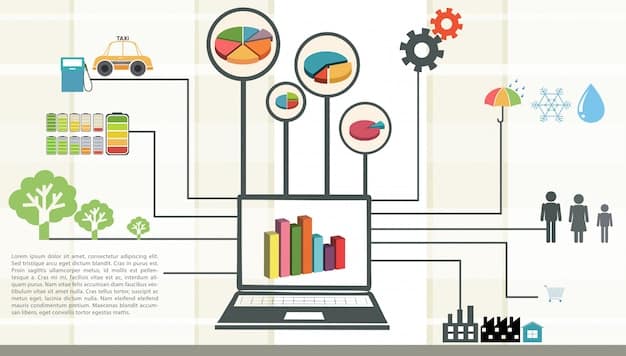Supply Chain Disruptions: Q1 2025 Shipping Cost Forecasts Unveiled

An expert analysis of current global freight trends indicates that supply chain disruptions are projected to cause a 15% increase in shipping costs for the first quarter of 2025, primarily due to geopolitical tensions, climate events, and evolving consumer demand patterns.
The intricate web of global commerce is perpetually in motion, adapting to a myriad of external forces. As businesses and consumers alike navigate an increasingly volatile economic landscape, understanding the future trajectory of logistics is paramount. A fresh expert analysis has pinpointed a critical development: supply chain disruptions are set to drive a significant 15% surge in shipping costs for Q1 2025. This projection demands immediate attention and strategic foresight from all stakeholders.
The compounding factors behind soaring shipping costs
The global shipping industry, the lifeblood of international trade, is currently grappling with a confluence of multifaceted challenges. These issues, ranging from geopolitical unrest to environmental shifts, collectively exert immense pressure on operational expenditures, inevitably leading to increased costs for businesses and, ultimately, consumers. Understanding these root causes is the first step toward effective mitigation.
Geopolitical tensions and their domino effect
Recent flare-ups in international relations and regional conflicts have proven to be significant disruptors. Shipping routes through critical chokepoints become high-risk zones, forcing carriers to re-route vessels over longer distances. This not only adds days to transit times but also escalates fuel consumption and insurance premiums. The rerouting of ships around the Cape of Good Hope, for instance, significantly extends journeys from Asia to Europe, driving up operational costs.
Furthermore, trade tariffs and sanctions imposed by various nations create additional layers of complexity and expense. Companies must navigate complex regulatory landscapes, often incurring higher administrative costs and sometimes being forced to seek alternative, more expensive suppliers or shipping partners. The cumulative effect is a substantial upward pressure on freight rates.
- Increased fuel consumption due to longer routes.
- Elevated insurance premiums for vessels in high-risk areas.
- Higher administrative costs from navigating complex tariffs.
- Extended transit times impacting inventory management.
These geopolitical shifts create an environment of uncertainty that shipping lines often factor into their pricing, building in risk premiums that contribute directly to the projected cost increases.
Climate change and extreme weather events
The accelerating pace of climate change introduces another layer of unpredictability. Severe weather phenomena, such as hurricanes, extreme droughts, and unprecedented floods, directly impact port operations and inland transportation networks. Ports can shut down for days, leading to significant backlogs and demurrage charges.
Droughts, particularly those affecting crucial waterways like the Panama Canal, reduce vessel capacity and create bottlenecks, forcing shippers to pay premium prices for limited slots or explore alternative, lengthier routes. The increased frequency and intensity of these events make long-term capacity planning incredibly challenging, pushing carriers to compensate for potential delays and damages through higher fees.
In essence, the physical risks posed by a changing climate are becoming quantifiable costs within the shipping matrix, significantly contributing to the overall 15% projected rise.
The ripple effect: how these costs impact businesses
The projected 15% increase in shipping costs for Q1 2025 isn’t merely a statistic; it represents a tangible challenge for businesses across every sector. From small and medium-sized enterprises (SMEs) to multinational corporations, the impact will be felt profoundly, compelling companies to re-evaluate their strategies and operations. The immediate and most apparent consequence is a direct hit to profit margins, especially for businesses operating with tight financial buffers.
Erosion of profit margins
For companies that rely heavily on global trade, such as retailers, manufacturers, and e-commerce platforms, increased shipping costs directly translate into lower profitability. If these businesses absorb the entirety of the cost increase, their net profits will shrink. This is particularly challenging in competitive markets where price elasticity is high, making it difficult to pass on additional expenses to consumers without losing market share.
Conversely, if companies opt to transfer these higher costs to their customers, it can lead to increased retail prices, potentially dampening consumer demand and overall sales volumes. This delicate balancing act between maintaining profit margins and preserving customer loyalty becomes a critical strategic dilemma. Businesses must carefully assess their pricing power and the competitive landscape before making such decisions.
Inventory management and supply chain vulnerabilities
Higher shipping costs often coincide with longer transit times and increased unpredictability. This combination forces businesses to rethink their inventory strategies. Companies might decide to hold larger safety stocks to mitigate the risk of stockouts due to delayed shipments. However, holding more inventory incurs additional costs, including warehousing, insurance, and the risk of obsolescence, further straining financial resources.
Moreover, the increased volatility exposes inherent vulnerabilities within existing supply chains. Dependencies on single suppliers or specific shipping routes become risky propositions. Businesses are compelled to diversify their sourcing and logistics networks, which often involves upfront investments or less efficient, albeit more resilient, alternatives. The quest for resilience often comes with a higher price tag, contributing to overall operational expenses.

Expert analysis and predictive models for Q1 2025
The projection of a 15% increase in shipping costs for Q1 2025 did not emerge from a vacuum. It is the result of sophisticated analysis by leading economists, logistics experts, and data scientists who employ a range of predictive models and incorporate a multitude of real-time indicators. Their work provides a crucial early warning system for the global economy.
Data-driven insights and forecasting methodologies
Leading analytical firms utilize extensive datasets, including historical freight rates, container availability, port congestion data, fuel price futures, and geopolitical risk assessments. These data points are fed into complex econometric models that identify correlations and predict future trends. Machine learning algorithms are increasingly being deployed to detect subtle patterns and anomalies that human analysts might miss.
Furthermore, qualitative insights from industry leaders, interviews with major shipping line executives, and global trade policy experts supplement quantitative data. This holistic approach ensures that the forecasts are not just statistically sound but also grounded in practical industry realities. The 15% figure is an average, with specific routes and cargo types potentially experiencing higher or lower increases based on their unique risk profiles.
Key indicators monitored for future disruptions
Analysts continuously monitor several critical indicators to refine their projections. The Shanghai Containerized Freight Index (SCFI) and the Drewry World Container Index (WCI) are crucial barometers for spot freight rates. Any sustained upward movement in these indices signals deeper underlying cost pressures. Bunker fuel prices, derived from crude oil values, are another direct cost component that is closely watched.
- Global geopolitical stability indices.
- Crude oil and bunker fuel price trends.
- Port congestion levels and average vessel waiting times.
- New vessel order books and scrapping rates.
- Consumer demand forecasts and inventory levels.
Updates on new regulations, such as those related to environmental compliance in shipping, are also factored in, as these can impose significant costs on carriers. The collective intelligence gathered from these diverse sources paints a clear, albeit challenging, picture for the upcoming quarter.
Mitigation strategies: adapting to the new shipping cost reality
Faced with the impending 15% hike in shipping costs, businesses cannot afford to remain static. Proactive and adaptive mitigation strategies are essential to minimize financial impact and maintain competitive edge. The emphasis must shift from simply reacting to disruptions to building resilient and agile supply chain ecosystems.
Diversifying logistics and supply networks
Sole reliance on a single shipping lane, carrier, or even a single mode of transport is a significant vulnerability. Companies should assess the possibility of diversifying their logistics providers, negotiating contracts with multiple carriers to ensure flexibility and leverage competitive pricing. Exploring multimodal transport options – combining sea, air, rail, and road – can also provide alternatives when one mode faces severe disruption.
Beyond logistics, diversifying the geographical footprint of sourcing and manufacturing is crucial. “China Plus One” strategies, where companies spread production across additional countries, are gaining traction. While this may increase initial setup costs, it significantly reduces exposure to localized disruptions and strengthens overall supply chain resilience. The goal is to create a more distributed and less centralized network.
Technology adoption and optimization
Leveraging advanced technologies can unlock significant efficiencies and cost savings. Supply chain visibility platforms, powered by AI and real-time data analytics, provide end-to-end transparency, allowing companies to track shipments, anticipate delays, and reroute cargo proactively. Predictive analytics can optimize inventory levels, reducing the need for costly last-minute orders or excessive buffer stock.
Automation in warehousing and logistics operations, from robotics to intelligent sorting systems, can reduce labor costs and improve throughput. Furthermore, blockchain technology is emerging as a tool to enhance transparency and security in documentation and transactions, potentially streamlining processes and reducing administrative overheads. Investing in these digital tools is no longer a luxury but a strategic imperative.

The long-term outlook: building resilient global supply chains
The projected increase in shipping costs for Q1 2025 is a stark reminder that supply chain resilience is not a temporary buzzword but a fundamental requirement for sustained business success. The volatility seen over the past few years suggests that “normal” may be a distant memory, replaced by an era of perpetual adaptation. Consequently, the long-term outlook emphasizes a fundamental re-engineering of global supply chains.
Regionalization and nearshoring trends
While globalization has driven cost efficiencies for decades, the current environment is accelerating a trend towards regionalization and nearshoring. Bringing production closer to end consumers can significantly reduce lead times and logistics costs, especially for high-value or time-sensitive goods. This shift also mitigates risks associated with long-distance shipping, such as geopolitical conflicts or natural disasters.
Governement incentives and infrastructure investments in regional manufacturing hubs are further supporting this trend. While complete reshoring might not be feasible for all industries, a balanced approach that combines global sourcing for certain components with regional assembly or final production offers a robust strategy. This creates diversified supply nodes that are less susceptible to single-point failures.
Embracing predictive analytics and AI
The future of supply chain management lies squarely in the effective utilization of predictive analytics and Artificial Intelligence. AI-driven platforms can analyze vast quantities of data – from weather patterns to geopolitical news feeds and customs regulations – to anticipate disruptions before they materialize. This capability allows businesses to adjust their strategies proactively, whether by re-routing shipments, adjusting production schedules, or renegotiating contracts.
Beyond prediction, AI can optimize complex logistical challenges, such as route optimization, warehouse automation, and demand forecasting with unprecedented accuracy. These technologies move companies from reactive crisis management to proactive risk mitigation, transforming potential threats into opportunities for competitive advantage. The sophistication of these tools will be a defining factor in future supply chain resilience.
Beyond economics: the environmental and social impacts
While the immediate focus of a 15% shipping cost increase is understandably on economic implications, it is imperative to consider the broader environmental and social impacts. These aspects are increasingly intertwined with operational decisions and carry significant long-term consequences for businesses and the planet.
Environmental considerations and sustainability
Increased shipping costs, particularly those driven by longer routes due to geopolitical or climate reasons, inherently mean higher fuel consumption and, consequently, increased carbon emissions. This runs counter to global efforts to decarbonize the shipping industry. Businesses striving for sustainability goals will face a dilemma: absorb higher costs to maintain efficiency or choose less carbon-intensive but potentially slower and more expensive transport options.
The imperative to reduce environmental footprint might accelerate the adoption of cleaner fuels and propulsion technologies in the shipping sector, but these initiatives often come with significant upfront costs that contribute to higher freight rates in the short to medium term. The balance between cost-efficiency and environmental responsibility will be a continuous challenge for logistics planners.
Social equity and labor conditions
The global shipping industry relies heavily on a workforce that operates under challenging conditions. Increased demand, longer routes, and intensified pressure to deliver goods despite disruptions can exacerbate issues like seafarer fatigue, mental health challenges, and even exploitation in some segments of the shipping industry. Businesses have a social responsibility to ensure ethical practices throughout their supply chains, including transportation.
Furthermore, higher shipping costs contribute to inflation, which disproportionately affects lower-income households. The knock-on effect of increased prices for imported goods can reduce purchasing power and living standards. Understanding these broader social implications can inform more holistic corporate social responsibility (CSR) strategies, encouraging investment in resilient and socially equitable supply chains rather than merely cost-cutting measures.
Conclusion: navigating the turbulent waters of global trade
The projected 15% increase in shipping costs for Q1 2025, driven by persistent supply chain disruptions, is more than just a financial forecast; it is a critical signal for businesses worldwide. This analysis underscores the ongoing volatility of global trade, shaped by geopolitical tensions, the escalating impacts of climate change, and evolving market dynamics. For enterprises of all sizes, the message is clear: proactive adaptation, strategic diversification, and robust investment in technology are no longer optional but essential for survival and growth.
Moving forward, success in this unpredictable environment will hinge on an organization’s ability to transform challenges into opportunities. By embracing advanced analytics, fostering greater supply chain visibility, and prioritizing both resilience and sustainability, companies can not only mitigate the immediate financial impact of rising costs but also build more robust, ethical, and future-proof global operations. The journey ahead demands agility, foresight, and a collaborative spirit to navigate the turbulent waters of international logistics.
| Key Point | Brief Description |
|---|---|
| 🌍 Geopolitical Impact | Conflicts and tariffs force costly re-routing and higher insurance, directly increasing freight rates. |
| 🗓️ Q1 2025 Forecast | Expert analysis projects a 15% rise in shipping costs due to ongoing disruptions. |
| ⚙️ Mitigation Strategies | Diversifying logistics, adopting technology, and nearshoring are crucial for resilience. |
| 🌱 Holistic Considerations | Environmental impact and social equity are increasingly critical aspects of supply chain management. |
Frequently asked questions (FAQs)
The projected 15% increase is primarily attributed to a combination of persistent geopolitical tensions causing re-routing, a surge in demand for goods, and ongoing climate-related disruptions like severe weather affecting port operations and key waterways. These factors collectively push up operational costs for shipping carriers, which are then passed on to businesses through higher freight rates.
Key drivers include geopolitical conflicts (e.g., Red Sea attacks affecting Suez Canal traffic), extreme weather events (e.g., droughts impacting Panama Canal, hurricanes disrupting port operations), labor shortages in logistics sectors, and the residual effects of post-pandemic shifts in consumer demand patterns which strain shipping infrastructure and capacity.
To mitigate impact, businesses should diversify their logistics and supplier networks, explore nearshoring or regionalization strategies, invest in supply chain visibility tools and predictive analytics, and consider multi-modal transport options. Negotiating flexible contracts with multiple carriers and optimizing inventory management are also crucial steps.
Yes, it is highly likely that increased shipping costs will, to some extent, be passed on to consumers. Businesses typically absorb a portion of rising costs to remain competitive, but significant increases often lead to higher retail prices for goods. The exact impact on consumer prices will vary depending on the product, market competition, and brand pricing strategies.
Technology is pivotal. Advanced analytics and AI can provide real-time visibility into supply chain operations, predict potential disruptions, and optimize routes and inventory. Automation (e.g., robotics in warehouses) can improve efficiency, while digital platforms enable better communication and collaboration between supply chain partners, enhancing overall resilience and responsiveness.
Conclusion
The projected 15% increase in shipping costs for Q1 2025, driven by persistent supply chain disruptions, is more than just a financial forecast; it is a critical signal for businesses worldwide. This analysis underscores the ongoing volatility of global trade, shaped by geopolitical tensions, the escalating impacts of climate change, and evolving market dynamics. For enterprises of all sizes, the message is clear: proactive adaptation, strategic diversification, and robust investment in technology are no longer optional but essential for survival and growth.
Moving forward, success in this unpredictable environment will hinge on an organization’s ability to transform challenges into opportunities. By embracing advanced analytics, fostering greater supply chain visibility, and prioritizing both resilience and sustainability, companies can not only mitigate the immediate financial impact of rising costs but also build more robust, ethical, and future-proof global operations. The journey ahead demands agility, foresight, and a collaborative spirit to navigate the turbulent waters of international logistics.





